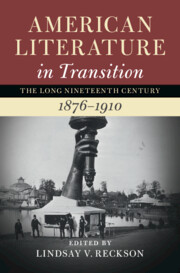Book contents
- American Literature in Transition, 1876–1910
- Nineteenth-Century American Literature in Transition
- American Literature in Transition, 1876–1910
- Copyright page
- Contents
- Contributors
- Series Preface
- Acknowledgments
- Chronology
- Introduction
- Part I Transitive States
- Part II Post-Reconstruction Aesthetics
- Part III Old Materialisms
- Part IV Immanent Techniques
- Chapter 15 Frances Harper’s Reconstruction
- Chapter 16 Emma Lazarus’s Cosmopolitanism
- Chapter 17 Henry James’s Temporalities
- Chapter 18 Charlotte Perkins Gilman’s Pragmatism
- Chapter 19 Nicholas Black Elk’s Cosmology (or, Post-Reconstructing Black Elk)
- Index
Chapter 18 - Charlotte Perkins Gilman’s Pragmatism
from Part IV - Immanent Techniques
Published online by Cambridge University Press: 24 August 2022
- American Literature in Transition, 1876–1910
- Nineteenth-Century American Literature in Transition
- American Literature in Transition, 1876–1910
- Copyright page
- Contents
- Contributors
- Series Preface
- Acknowledgments
- Chronology
- Introduction
- Part I Transitive States
- Part II Post-Reconstruction Aesthetics
- Part III Old Materialisms
- Part IV Immanent Techniques
- Chapter 15 Frances Harper’s Reconstruction
- Chapter 16 Emma Lazarus’s Cosmopolitanism
- Chapter 17 Henry James’s Temporalities
- Chapter 18 Charlotte Perkins Gilman’s Pragmatism
- Chapter 19 Nicholas Black Elk’s Cosmology (or, Post-Reconstructing Black Elk)
- Index
Summary
Among scholars of American literature, Charlotte Perkins Gilman is best known as a one-story, or more accurately, a two-story author. With “The Yellow Wallpaper,” published in 1892 in The New England Magazine and largely anthologized ever since, and Herland, her 1915 novella, rediscovered and republished in 1979 as “A Lost Feminist Utopian Novel,” Gilman is now well established in the feminist canon of American turn-of-the century literature, and it is common practice to read her (two) texts alongside other provocative gems such as Mary E. Wilkins Freeman’s “Old Woman Magoun” or Kate Chopin’s “The Story of an Hour.”1 Gilman the feminist writer, then, is a familiar figure; as is, among social historians, Gilman the socialist reformer; or among sociologists, Gilman the social theorist, an acolyte to Jane Addams’s pragmatist experiments and an advocate for alternative urban planning and home economics.2 A victim of the disciplinary mode of thinking that was consolidating at the time when she was writing, Gilman the writer, however, has remained a puzzle of sorts – a reformer who happened to write literature, or a poet manqué who used her pen as a sword. Have we missed something?
- Type
- Chapter
- Information
- American Literature in Transition, 1876–1910 , pp. 345 - 366Publisher: Cambridge University PressPrint publication year: 2022



